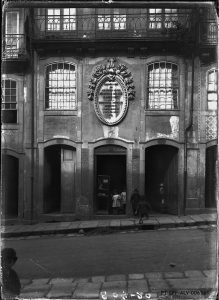Documento Mês – Fundos e Coleções

Casa onde nasceu Almeida Garrett, Porto, 1920-1950
PT/CPF/ALV/006561
Almeida Garrett é considerado, por muitos autores, como o escritor português mais completo de todo o século XIX, porquanto nos deixou obras-primas na poesia, no teatro e na prosa, inovando a escrita e a composição em cada um destes géneros literários.
Desde 1864 que a casa onde Almeida Garrett nasceu e passou os primeiros cinco anos de vida, situada nas traseiras da muralha fernandina, ostenta na fachada, ao nível do 1.º piso, um medalhão em gesso, de sabor neoclássico, patrocinado pela Câmara Municipal do Porto, com a seguinte inscrição, em letras maiúsculas: “Casa onde nasceu aos 4 de fevereiro de 1799 João Baptista da Silva Leitão de Almeida Garrett / Mandou gravar à memória do grande poeta a Câmara Municipal d’esta cidade em 1864”.
Trata-se de uma casa construída na segunda metade do século XVIII, durante a reforma urbanística dos Almadas. Contém quatro pisos, com três vãos em cada – com exceção do primeiro que alberga a citada lápide – simetricamente alinhados verticalmente. Almeida Garrett é uma das figuras mais prestigiadas do Porto, como evidenciam a estátua em sua homenagem, situada num ponto central da Avenida dos Aliados, e a biblioteca municipal que leva o seu nome. A sua trajetória foi marcada pela defesa apaixonada dos ideais liberais, o que o levou ao exílio em Inglaterra, onde entrou em contato com os ideais românticos que influenciaram profundamente a sua produção literária. Após a implantação da monarquia constitucional, a qual ajudou a estabelecer, Garrett assumiu cargos políticos e diplomáticos de destaque, sendo uma figura fundamental na renovação do teatro português.
Almeida Garrett is considered by many authors to be the most complete Portuguese writer of the 19th century, as he left masterpieces in poetry, theatre, and prose, innovating both writing and composition in each of these literary genres.
Since 1864, the house where Almeida Garrett was born and spent his first five years of life, located behind the Fernandina Wall, has featured a neoclassical-style plaster medallion on the facade at the first-floor level. This was funded by the City Hall of Porto and bears the following inscription in capital letters: “House where João Baptista da Silva Leitão de Almeida Garrett was born on February 4, 1799 / Engraved in memory of the great poet by the City Hall of this city in 1864.”
This is a house built in the second half of the 18th century during the Almadas’ urban reform. It has four floors, with three windows on each—except for the first, which houses the aforementioned plaque—symmetrically aligned vertically.
Almeida Garrett is one of the most prestigious figures in Porto, as evidenced by the statue in his honour, located in a central spot on Avenida dos Aliados, and the municipal library named after him. His life trajectory was marked by his passionate defence of liberal ideals, which led him into exile in England, where he came into contact with the Romantic ideals that profoundly influenced his literary work. After the establishment of the constitutional monarchy, which he helped create, Garrett held important political and diplomatic positions, being a key figure in the renewal of Portuguese theatre.